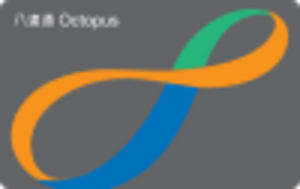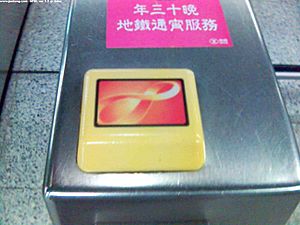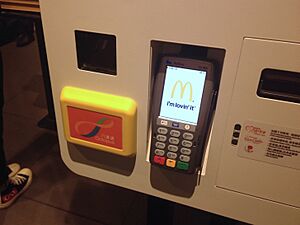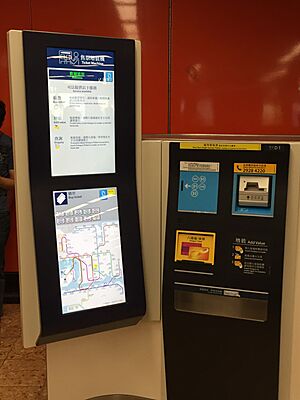Octopus card facts for kids

Adult version of the Octopus card since 2017
|
|
| Location | Hong Kong |
|---|---|
| Launched | 1 September 1997 |
| Technology |
|
| Operator | Octopus Cards Limited |
| Currency | HKD (HK$3,000 maximum load) |
| Stored-value | Pay as you go |
| Auto recharge | Automatic Add Value Service (through credit cards or FPS) |
| Validity |
|
| Octopus card | |||||||||||||
|---|---|---|---|---|---|---|---|---|---|---|---|---|---|
| Traditional Chinese | 八達通 | ||||||||||||
| Simplified Chinese | 八达通 | ||||||||||||
|
|||||||||||||
The Octopus card (Chinese: 八達通; Jyutping: baat3 daat6 tung1, Cantonese)) is a special smart card used for making electronic payments in Hong Kong. It's like a digital wallet you can carry! You don't need to touch the card to the reader; just hold it close.
The Octopus card was first launched in September 1997. It was created to help people pay for rides on Hong Kong's public transport system. Since then, it has become super popular for paying for many other things, like shopping and food. It's even used in some schools to record attendance and help people get into buildings. Almost everyone in Hong Kong between 15 and 64 years old uses an Octopus card. Every day, over 15 million payments are made with these cards!
The Octopus card system was one of the first contactless smart card systems in the world. Its success inspired other cities to create similar systems, like the Oyster card in London and the Navigo card in Paris.
Contents
How the Octopus Card Began
When Hong Kong's Mass Transit Railway (MTR) started in 1979, it used special magnetic tickets. Later, other transport companies like the Kowloon-Canton Railway (KCR) also used similar tickets. In 1989, these tickets could even be used on some buses.
In 1993, the MTR decided to switch to a new, more advanced system using contactless smart cards. They teamed up with other big transport companies in Hong Kong to create a new company called Creative Star Limited.
Launching the Octopus Card
After three years of testing, the Octopus card was finally launched on September 1, 1997. It became popular very quickly. One reason was that people had to switch from their old tickets to the new Octopus cards. Another reason was a shortage of coins in Hong Kong that year. Many people were holding onto their old coins, hoping they would become more valuable. The Octopus card offered an easy way to pay without needing exact change.
By 2000, most bus trips in Hong Kong were paid for using an Octopus card. It was much easier than trying to find the exact coins for the bus fare! By 2002, over 9 million Octopus cards were being used.
Octopus Rewards Program
In 2005, Octopus Cards Limited started a program called Octopus Rewards. This allowed cardholders to earn points when they shopped at certain stores. These points, called reward dollars, could then be used to pay for things at those same stores.
New and Improved Cards
New Octopus cards with better security features were released in 2015. Older cards eventually stopped working in January 2018, so people needed to get the newer versions.
In March 2024, a new Octopus card was launched that works with the China T-union network. This means you can use your Octopus card to pay for public transport in many cities in mainland China! You top up the card with Hong Kong dollars, and it automatically changes to Chinese money when you use it in China.
What "Octopus" Means
The Chinese name for the Octopus card is Baat Daaht Tùng (八達通). This name means "eight-arrived pass" or "reaching everywhere." It was chosen in a competition in 1996. The number eight is important because it refers to all directions (north, south, east, west, and the ones in between). It also sounds a bit like a phrase that means "getting wealthy" in Cantonese, which is considered lucky!
The English name Octopus card was also chosen in the same competition. It refers to the number eight because an octopus animal has eight tentacles. The logo on the card looks like an infinity symbol, which means something that goes on forever.
How to Use Your Octopus Card

The Octopus card was first made for paying transport fares, but it quickly became useful for many other things. Today, you can use it in most public transport, fast food places, supermarkets, vending machines, convenience stores, and even for parking. As of 2018, over 33 million Octopus cards were in use, with 99% of Hong Kong residents using one!
Big stores like PARKnSHOP, Wellcome, 7-Eleven, and McDonald's started accepting Octopus cards early on. The Hong Kong Government even changed its parking meters to accept Octopus cards in 2003 and 2004.
Octopus cards are also used as access cards in some buildings and schools. You might need to tap your card to enter certain offices, homes, or school buildings.
Making Payments
To pay, you just hold your Octopus card close to an Octopus card reader. The reader will make a beep sound, show you how much was taken off your card, and tell you your remaining balance. It's super fast! For public transport, it takes less than half a second.
Public Transport Payments
When you use the MTR train system, the card records where you start your journey. When you tap it again at your exit, it calculates the correct fare based on how far you traveled.
Using an Octopus card for MTR journeys is usually cheaper than buying a single ticket. For example, a trip from Chai Wan to Tung Chung costs less with an Octopus card. Other transport companies also offer discounts if you use your Octopus card.
Taxi Payments
In March 2018, Octopus Cards Limited started new plans for taxi payments. They launched a mobile app for taxi drivers. Drivers can use their phone's NFC to read a passenger's Octopus card, or passengers can scan a QR code to pay.
In October 2020, a smaller Octopus reader called Octopus Mobile POS was launched. This helped taxi drivers and small shops accept cashless payments, which was especially helpful during the COVID-19 pandemic for safety. By July 2021, over 15,000 taxi drivers were using this new system.
Using Octopus Outside Hong Kong
The Octopus card can also be used in some places outside Hong Kong. In August 2006, some Fairwood restaurants in Shenzhen, China, started accepting Octopus cards. In 2008, some Café de Coral restaurants there also began to accept them. You can't add money to your Octopus card in Shenzhen, but if you have the Automatic Add Value Service, it can top up your card from your credit card.
In December 2006, two Kentucky Fried Chicken restaurants in Macau also started accepting Octopus cards. Just like in Shenzhen, you can't add money to your card in Macau.
Since March 26, 2024, a new Octopus card version can be used in mainland China and Macau through the China T-Union system.
Checking Balance and Adding Money
You can check how much money is left on your Octopus card and add more money at many places. These include MTR stations, convenience stores, supermarkets, and even special "Coin Carts" run by the Hong Kong Monetary Authority where you can add your spare coins.
Different Kinds of Octopus Cards
There are two main types of Octopus cards: On-Loan cards and Sold cards.
On-Loan Cards
On-Loan cards are the most common type. They are used for everyday payments, especially for transport. They come in different categories: Child, Adult, Elder, and Personalised. The first three are based on age and offer different discounts.
Most On-Loan cards are anonymous, meaning they don't store your personal information. If you lose one, only the money on the card is lost. You can buy On-Loan Octopus cards at MTR stations and other transport service centers.
| Type | Colour | Cost and use |
|---|---|---|
| Adult |
|
This is the standard Octopus card. It costs HK$200 and comes with HK$150 already on it. |
| Child |
|
For children aged 3 to 12. This card costs HK$100 and has HK$50 on it. It gives you child fares where available. |
| Elder |
|
For senior citizens aged 65 or older. These cards allow for special discounted fares, often costing only HK$2 per trip. It costs HK$100 and has HK$50 on it. |
| Personalised |
|
This card has your name printed on it and can even have your photo. It costs HK$200 and comes with HK$130. There's also a small handling fee.
|
Octopus on Your Phone
You can also use Octopus on your smartphone! This is called "Smart Octopus" or "Mobile Octopus."
Samsung Pay
Since December 14, 2017, you can use "Smart Octopus" with Samsung Pay. You can transfer your existing Octopus card to your Samsung phone or buy a new one in the app. Then, you just tap your phone on the Octopus reader, just like a physical card! You can also add money to your card directly from the app.
Apple Pay
Since June 2, 2020, Octopus cards can be added to Apple Pay. If you have an Apple Watch 3, iPhone 8, or a newer model, you can create a virtual Octopus card or transfer your physical card to your Apple device. It works with Apple Pay's Express Transit, so you don't even need to unlock your phone to pay!
Huawei Pay
Since December 9, 2020, Octopus cards can be added to Huawei Pay. This works on Huawei phones sold in Hong Kong, Macau, and China. You can buy new cards or transfer existing ones using the Octopus app from Huawei AppGallery.
Google Wallet
Since April 28, 2024, you can buy new Mobile Octopus cards through the Octopus Apps from the Google Play Store. This works on Android phones with version 12 or higher, as long as they have NFC and are connected to the internet. You can add this card to your Google Wallet.
How the Technology Works
The Octopus card system was designed and built by an Australian company called ERG Group (now Vix Technology). The Octopus card uses a special chip called FeliCa from Sony. This chip allows the card to communicate with the reader without touching it. It's very fast, sending data much quicker than older smart card systems.
The Octopus system is designed so that payments are recorded and then sent to a central computer later. This means the readers don't need to be constantly connected to the internet. For example, MTR stations have networks that connect all the Octopus machines, and their transactions are sent to the MTR headquarters. Buses might use handheld devices or wireless systems to collect the payment data.
Security of the Card
The Octopus card uses encryption to keep your information safe when it talks to the reader. The card and reader check each other to make sure they are real before sharing any information. This helps prevent people from trying to trick the system. As of 2003, the Octopus card system had never been hacked.
The Octopus card readers also have a safety feature: they won't work if they detect more than one card at a time. This is to stop accidental payments.
Who Runs the Octopus System
The Octopus card system is owned and run by Octopus Cards Limited. This company was first called Creative Star Limited when it started in 1994, but it changed its name in 2002.
Octopus Cards Limited is part of a bigger company called Octopus Holdings Limited. Since it handles payments, Octopus Cards Limited is watched over by the Hong Kong Monetary Authority to make sure it's safe and fair.
The company is owned by several transport companies in Hong Kong. The MTR Corporation owns the biggest part. Since the Government of Hong Kong owns a large part of the MTR Corporation, the government is the biggest effective owner of the Octopus system.
Awards for the Octopus Card
The Octopus card system has won international awards. In 2006, it won the Chairman's Award at the World Information Technology and Services Alliance's Global IT Excellence Awards. It was recognized for being a leading and innovative system for collecting fares and making contactless payments.
Past Issues
Payment Glitch
In February 2007, a problem was found where customers' bank accounts were charged even if they canceled adding money to their Octopus cards at self-service machines. Octopus Cards Limited said it was due to a system upgrade. They stopped allowing payments using Electronic Payment Services (EPS) at these machines.
Later, it was found that this problem had been happening since 2000, and about HK$3.7 million had been wrongly charged in over 15,000 cases. The company worked with banks to refund the money to customers. In December 2007, they decided to permanently stop all EPS transactions at these machines because they couldn't guarantee the problem wouldn't happen again.
Privacy Concerns
In July 2010, it was revealed that Octopus Holdings had sold personal details of some customers to other companies. This caused a lot of concern about privacy. Octopus Holdings had made money from selling this data. Hong Kong's Privacy Commissioner for Personal Data called for an investigation and for new laws to make it a crime for companies to sell personal data without permission.
Images for kids
See also
 In Spanish: Tarjeta Octopus para niños
In Spanish: Tarjeta Octopus para niños






